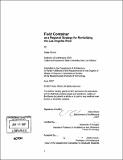Field container as a regional strategy for revitalizing the Los Angeles River
Author(s)
Ghole, Saba (Saba Ashfaq)
DownloadFull printable version (21.77Mb)
Other Contributors
Massachusetts Institute of Technology. Dept. of Architecture.
Advisor
Alexander D'Hooghe.
Terms of use
Metadata
Show full item recordAbstract
This thesis is the study of the Los Angeles River as a multi-layered field with urban condensers that revitalize the river, connect and revitalize the municipal districts bordering the river, and restructure the region to support a denser fabric. The project establishes the nature of public space in the city as a highly contested sphere of multiple interests and constituencies and utilizes the river as a platform to engage these tensions. The Los Angeles River epitomizes the artificiality and ingenious of Los Angeles as a city which molded its environment to suit its will, inhabiting a dry, arid desert and structuring one of the largest metropolises in the world. The merging of these two instances, the particular geography of Southern California and man's desire and ingenuity to overcome this nature by man's engineering is the story of how Los Angeles became a global city from an agricultural village. With a population approaching four-million inhabitants, the city is examined after the Southern California development phenomena of "dense sprawl" and is used as a model to examine the future potential of the river, currently a mono-functioning, concretized flood control channel, to become a multi-functioning infrastructure mediating a density of program and flows at the regional, metropolitan and local scales. (cont.) The thesis examines the river's stretch from the Glendale Narrows through downtown to the city of Vernon and the creation of a public landscape armature with six urban condensers, areas designed according to a set of criteria that challenge the current condition of urban infill and the erasure of public open space. The expectation is that these projects will engage the socio-economic complexity of Los Angeles and overcome the limitations posed by jurisdictional boundaries.
Description
Thesis (S.M.)--Massachusetts Institute of Technology, Dept. of Architecture, 2007. Includes bibliographical references (p. 121).
Date issued
2007Department
Massachusetts Institute of Technology. Department of ArchitecturePublisher
Massachusetts Institute of Technology
Keywords
Architecture.